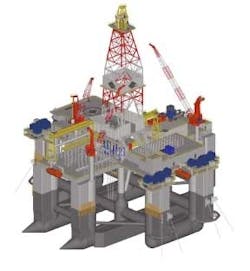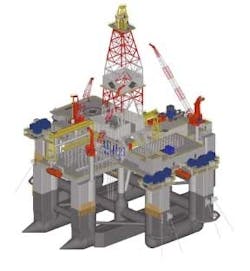DRILLING RIG ECONOMICS: Second, third generation semisubmersible drilling fleets positioned for upgrades
At the end of 1995, the demand for harsh-environment mobile drilling rigs capable of drilling in 1,500-5,000 ft water depths outpaced the supply. Today, as drilling activity moves beyond the 5,000 ft water depth contour (ultra-deepwater), rig history could repeat itself.
During the 1996-1998 period, a total of 30 semisubmersibles (semis) were upgraded in order to fill deepwater market needs. By 1999, the industry experienced a downturn and the number of upgrades tapered off. Today, with ultra-deepwater capable rigs commanding strong day rates and ultra-deep drilling expanding around the globe, another phase of upgrading may be getting underway.
Oil and gas producers' exploration and prod-uction (E&P) budgets are rising significantly this year, according to spending estimates by Lehman Brothers and others. In 2000, the majors allocated only 3% of their budgets for E&P; this year, the number has skyrocketed to 19%. Independents invested considerably more than the majors last year, with 19% on average going into E&P. This year's budgets show a less dramatic increase than those of the majors, but averages about 20%.
Much of this budget increase will be spent in deepwater and ultra-deepwater drilling, a trend that drilling contractors are watching closely. At the same time, contractors are mindful that equipment manufacturers are pushing the development of lighter, but robust, riser and seafloor systems that will not require the fifth generation drilling units. Why upgrade, when existing semis will suffice, and at the lower day rates that producers want? But will the technology arrive in time? Will drilling rig rates skyrocket in the meantime?
Contractors are trying to evaluate these issues and position their semisubmersible fleets to maximize utilization, now and in the future.
Semisubmersible fleet
At present, there are 75 second-generation semisubmersibles in operation. Nearly a third of these are in the Gulf of Mexico, with the North Sea showing the next greatest concentration. The Pacific Rim, West Africa, and Latin America come next in line. The remaining 7% are scattered around the world. With the vast majority of these semis working in areas where activity is moving into greater water depths, there is a collective opinion among drilling contractors that upgrading semis makes good economic sense.
But before the decision to upgrade is made, there are questions to be answered. Is there a need for fifth-generation semis? As drilling contractors look at deepwater activity in the Gulf of Mexico and other areas of the world, many contracting firm officials are answering "yes" to the upgrade question.
Semisubmersible utilization measures, as of February 1, 2001, show that the fourth generation and fifth generation semis are nearly all under contract. And while utilization numbers for the lesser second generation and third generation semis are far from disappointing, they show a comparatively large percentage sitting idle.
Four drilling contractors own nearly 50% of the second-generation and third-generation semisubmersibles in existence. Transocean Sedco Forex, which recently acquired RB Falcon Corp., now has the vast majority of semis in those two groups.
Contractor positions
Transocean is not doing any major up-grades at present, but a spokesman said the company is in the pro-cess of evaluating mo-bile rigs in relation to clients' needs, including their time requ-irements. With this evaluation, and other variables including cost, engineering design, and equipment-related issues, Transocean is making the necessary preparations to act quickly if and when contract opportunities arise.
Global Marine, with five third-generation semis and one fourth-generation semi, is another significant player. In terms of newbuilds and upgrades, Global's business approach is clear. Michael Dawson, Vice President of Investor Relations and Corporate Communica-tion, said that Global Marine will not undertake construction of any kind without a term contract in place. Company philosophy holds that a contract must be in hand before any construction begins. As a result, Global has not made decisions to upgrade the firm's semisubmersibles, but doesn't rule out a decision to upgrade if a term contract can be negotiated.
John O'Leary, Vice President of World Marketing at Pride International takes a similar view. However, he points out that some speculative new construction is likely. According to O'Leary: "Based on current forecasts, deep offshore (mobile rig) supply is inadequate to meet demand. The shortfall will be met from newbuilds on the one hand and from second-generation and third-generation upgrades on the other.
"The upgrades, in turn, will result in a tightening of supply in the second-generation and third-generation sector of the market, providing tremendous upside potential. As demand increases and some units are upgraded for deeper waters, we believe there will be a shortfall that should drive day rates higher."
Following that philosophy, Pride International purchased one second-generation and one third-generation semisubmersible, and both became part of Pride's fleet in February. Pride is already an established player in this sector of the market, with three semis operating off South Africa, West Africa, and Brazil.
Noble Drilling, which upgraded six semisubmersibles between 1997 and 1999, is looking closely at semisubmersibles with upgrade potential. Having met with success upgrading five semisubmersibles with the triangular design, the company is focusing on the Clyde Boudreaux as a prime upgrade candidate. Engineering has already been finalized for the upgrade, but the company will move ahead with construction only with a contract in hand.
From that point, Noble believes the upgrade can be completed in 18-20 months. There is a positive feeling that a contract will materialize given the growing number of deepwater exploration programs getting underway.
Two companies are approaching newbuilds and upgrades using their own capital. Santa Fe, which currently has two third-generation semisubmersibles, is in negotiations with several short-listed shipyards for construction of two more semisubmersibles. A construction contract award is expected later this quarter. Meanwhile, Diamond Offshore, whose fleet includes 30 semis, recently embarked on an upgrade to the Ocean Baroness (image on page 33).
Diamond has been putting a sizable amount of money into conversions and upgrades since 1996 and reportedly contemplated this particular upgrade for two years before determining to invest its own capital in the rig instead of holding construction until a contract could be negotiated. This is the first semi that Diamond has built on spec, which is a radical departure from traditional philosophy.
Diamond's view of future market needs led to the decision to upgrade the Ocean Baroness to 6,000 ft water depth capability in order to capitalize on the quickly growing deepwater drilling market. The upgrade includes about 6,200 tons operating variable deckload, 15,000 psi blowout preventers, and riser with a multiplex control system.
Additional features including a high capacity deck crane, significantly enlarged cellar deck area, and a 25 ft by 90 ft moon pool that will provide enhanced subsea completion and development capabilities. Diamond chose the Ocean Baroness for the upgrade, primarily because the rig had set idle and was in need of least $20 million in refurbishments in order to operate. The additional $160 million investment was deemed a reasonable risk by decision-makers at the cash-heavy company.
If the seemingly bright future of the deepwater market becomes a reality as most companies believe, Diamond will be well placed to cash in, and others won't be far behind.





